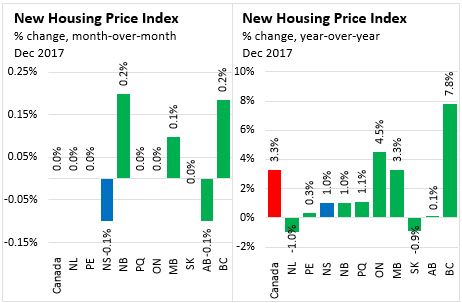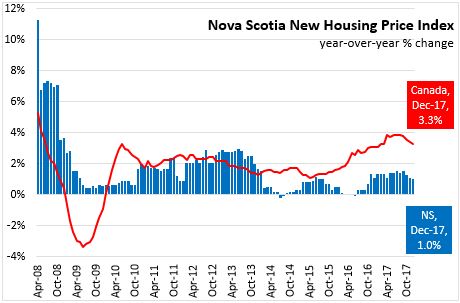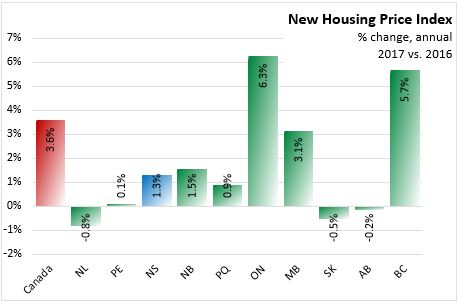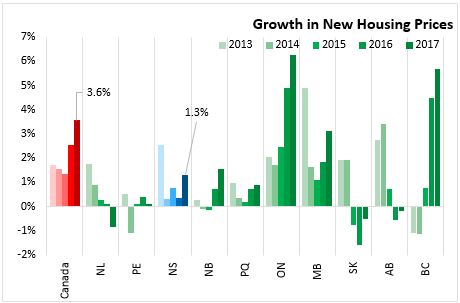The Economics and Statistics Division maintains archives of previous publications for accountability purposes, but makes no updates to keep these documents current with the latest data revisions from Statistics Canada. As a result, information in older documents may not be accurate. Please exercise caution when referring to older documents. For the latest information and historical data, please contact the individual listed to the right.
<--- Return to Archive
For additional information relating to this article, please contact:
February 08, 2018NEW HOUSING PRICE INDEX, DECEMBER AND ANNUAL 2017 DECEMBER 2017
In December, the price of new housing in Nova Scotia declined by 0.1 per cent to 101.0. Canada's new housing price index remained level at 103.3. In Canada, new housing prices have been on a general upward trend since 2009.

Nova Scotia new housing prices were 1.0 per cent higher than they were in December 2016. National housing prices were 3.3 per cent above their levels a year ago.
Across Canada, British Columbia (+7.8 per cent) and Ontario (+4.5 per cent) saw the largest increases in new housing prices from December 2016 to December 2017. Saskatchewan and Newfoundland and Labrador saw declines in new housing prices.
Since November 2016, year-over-year growth in the Nova Scotia new housing price index has been over 1.0 per cent, though they remain well below the national average. Year-over-year growth had started to come down from a high of 1.5% in July and September to 1.0% in December.

ANNUAL
In 2017, new housing prices in Nova Scotia were up 1.3 per cent compared to 2016. Canadian prices were 3.6 per cent higher. The highest growth in annual prices were seen in Ontario (+6.3 per cent) and British Columbia (+5.7 per cent), while annual prices declined in Newfoundland and Labrador, Saskatchewan, and Alberta. These results reflect recent trends in provincial housing markets, where Ontario and British Columbia continue to see strong growth in new housing prices. Nova Scotia, Manitoba, New Brunswick and Quebec grew faster in 2017 than 2016, while Newfoundland and Labrador declined in 2017. Although Saskatchewan's and Alberta's new housing prices have been in decline, the decline in 2017 was less than in previous years. PEI had an increase in 2017 which was smaller than 2016.


Census Metropolitan Areas
Among Census Metropolitan Areas tracked by the new housing price index, annual prices are growing faster around the Greater Toronto Area as well as in St. Catharines-Niagara, the Kitchener area, London, and Vancouver. New housing prices have declined in St. John's, Saskatoon, and Edmonton.

Statistics Canada Note: With the release of the January 2017 NHPI data, a number of important changes have been introduced to increase the relevance of the index series. The index base period, for which the NHPI equals 100, is now December 2016. The NHPI basket has been updated with new weights for the 2017 series, its coverage has been expanded to include new CMAs and new indexes have been published for the Toronto, Ottawa and Greater Sudbury areas. Data for periods prior to January 2017 have been obtained by linking the new NHPI series, where possible, with indexes in CANSIM table 327-0046.
Source Statistics Canada, CANSIM table 327-0056
<--- Return to Archive